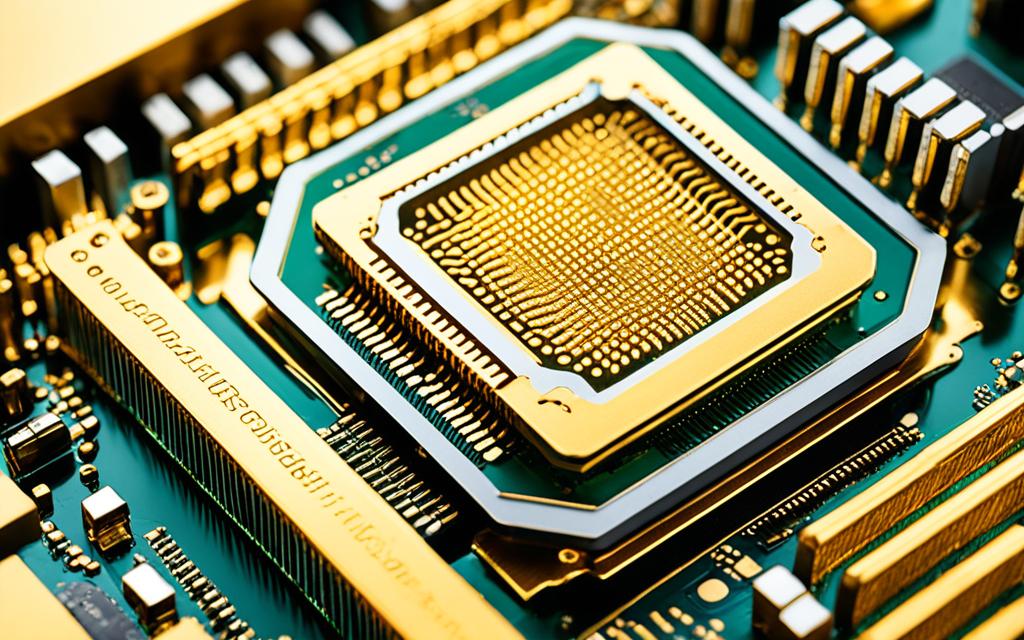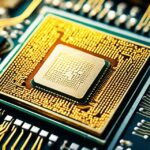Table of Contents
Exploring CPU gold content shows the meeting of tech and value. Gold is prized for its great conductivity and its fight against rust, making it key in CPU creation. When we look into CPU gold, it’s clear that gold isn’t just a part, but a crucial element within.
Its strong presence in critical parts like circuit boards and connectors underlines how vital precious metals are in electronics. This analysis will explore how the gold not only fills technical roles but also carries significant economic value123. This opens the door to understanding more about its extraction and the environmental costs.
Key Takeaways
- Gold is a critical material for ensuring electrical efficiency in CPUs.
- High-performance CPUs often contain significant amounts of gold in their connectors and circuit boards.
- The economic value of gold in CPUs highlights the importance of recycling electronic components.
- Environmental considerations arise from the extraction processes of gold in electronics.
- Understanding gold content can lead to better strategies for e-waste management and recovery.
The Significance of Gold in CPU manufacturing
Gold is key in making electronics, especially CPUs. It’s so good at conducting electricity and doesn’t get rusty, making it perfect for the job. Gold is not just for looks in devices; it makes sure they work smoothly.
Why Gold is Used in Electronics
The advantages of using gold in making CPUs are huge. It works great for parts like connectors and switches where you need a good electrical flow. Findings show that old electronics have more gold than new ones. This fact is exciting for those looking to recycle4. An old PC might have about $9 worth of gold. In contrast, a typical computer has less but still valuable gold, about 1/5th of a gram worth around $12. Space and defence industries also choose gold for its toughness in outer space, ensuring good connections and safeguarding against radiation4.
Advantages of Gold Connectors
Gold connectors offer big benefits like lasting a long time and fighting off rust. They help keep electrical connections stable, which is crucial for moving data quickly. The Intel Pentium Pro Processor is popular among recyclers for its rich gold content5. In the 1990s, top-notch solid gold wiring connected the computer chip to its base. This process used 99.99% pure gold5. These steps show how gold’s ability to avoid reacting keeps electronic parts running longer.
| Device Type | Gold Content (grams) | Value ($) |
|---|---|---|
| Old-school PC | ~0.5 | ~9 |
| Average Computer | ~0.2 | ~12 |
| Laptop | ~0.1 | ~6 |
| Industrial Video Equipment | Over 56 | Varies |
Common Components of a CPU that Contain Gold
In modern computers, components containing gold are key for top performance and reliability. Gold found in printed circuit boards (PCBs) stands out for its excellent conductivity and endurance. During CPU production, gold is used at different stages to boost their efficiency in many ways.
Gold in Printed Circuit Boards
Gold plays a crucial role in printed circuit boards, used for making trace patterns. These patterns are essential for electrical connections. Currently, the gold content in PCBs averages between 0.2 to 0.4 grams for each board. However, older versions like the Pentium Pro could have as much as 1-2 grams6.
Recycling PCBs is economically beneficial, thanks to the ongoing high demand for gold. Each year, the electronics industry uses up several tons of gold for various components7.
Gold Content in Connectors and Pins
CPUs have gold-plated pins that ensure smooth connectivity and boost system performance. For instance, newer CPUs, like those from Intel Core, have 0.1 to 0.5 grams of gold6. These gold connectors stop oxidation and maintain dependable electrical links, enhancing the system’s overall efficiency.
The careful removal of these parts highlights the value of gold recovery. Thus, recycling old CPUs is seen as worth the effort, for both economic and environmental reasons7.
How Much Gold is on a CPU
The amount of gold in CPUs varies a lot. This is very interesting for people who love electronics and those who recycle. They want to know how much gold these devices have.
Typical Gold Content in Various CPU Models
Some CPUs like the Pentium Pro have a lot of gold, about 1.0g. This is worth around $46.308. The AMD K5 has about 0.50g of gold, valued at $23.15. The NEC & Toshiba Server Chips hold 0.27g, worth $12.50 per CPU8. The Cyrix 686 has less gold, only 0.21g, making it worth $9.728. The Intel Celeron (green fibre) also has some gold. But, it’s not the best choice due to its iron content. Note, even though the Pentium Pro seems to have 1g of gold, you’ll likely only get about 0.33 grams from it9.
Factors Influencing Gold Quantity
Different CPUs have different amounts of gold because of several reasons. How they’re made and their design complexity matter a lot. The way gold content is measured can change with different refining techniques9. Also, the CPU’s condition and its parts can change how much gold you can actually get. This makes knowing the exact amount of gold very important.
| CPU Model | Gold Content (g) | Value (USD) |
|---|---|---|
| Pentium Pro | 1.0 | 46.30 |
| AMD K5 | 0.50 | 23.15 |
| NEC & Toshiba Server Chips | 0.27 | 12.50 |
| Original Intel Pentium (60MHz – 90MHz) | 0.48 | 22.22 |
| High Yield CPUs (e.g., Cyrix 686) | 0.21 | 9.72 |
| Low Yield CPUs | Varies | Lower than high yield CPUs |
Methods for Extracting Gold from CPUs
Getting gold from CPUs is a detailed task that changes with different methods used. Various CPU recycling methods aim to get as much gold as possible while cutting down on waste. This way, both companies and hobbyists can get valuable metals in an efficient manner.
Chemical Extraction Processes
The chemical extraction of gold involves special liquids that help remove gold from other substances in a CPU. For ceramic CPUs, up to 0.4-0.5 grams of gold can be found in each one10. A popular technique uses hydrochloric acid (HCl 32-36%), 20-30 ml per ceramic CPU, to dissolve metals well10.
Adding a bit of water to the acid helps accommodate metal ions in the solution better. It also keeps the process fast. Keeping the solution at 80-90°C when dissolving things helps get more gold10.
Recycling Practices in Electronics
Talking about CPU recycling methods includes looking at sustainability. Lots of electronic gadgets like computers, laptops, and smartphones have gold in them11. Computers, for instance, have a good amount of gold, giving about 0.2 g to 0.5 g of gold per CPU11.
Using the Borax Method allows for collecting gold flakes and dust well. It lowers the melting point so we can get the gold without using mercury12. When we melt parts from various devices, we can get 1-2 g of gold11. This shows that recycling is not just about getting resources. It also helps lessen electronic waste and shows care for the environment.
Environmental Impact of Gold Extraction
Getting gold and other valuable metals from CPUs is bad for our planet. It releases dangerous stuff like mercury and cadmium. Electronic waste is growing and will hit 74.7 million tonnes by 2030. We must act now to make CPU recycling safer13.
Hazardous Materials Associated with CPU Recycling
Recycling CPUs often uses toxic chemicals. This causes harm to the environment and health risks. The processes can leak bad substances into our soil and water. We need to ensure companies follow the best practices. This will reduce harm and make recycling safer14.
Best Practices for Reducing Environmental Damage
Companies need to use sustainable methods for gold extraction. They should recycle in a way that doesn’t harm, properly dispose of hazardous waste, and choose eco-friendly ways to get gold. By doing this, we can reduce the harm of gold extraction. We’ll also help to protect our planet for the future.
FAQ
What is the average gold content found in a CPU?
The average amount of gold in a CPU ranges greatly. It can be from a few milligrams up to tens of milligrams. This depends on the model and its unique features.
Why is gold crucial for CPU function?
Gold is key in CPUs because it conducts electricity very well. It also resists corrosion and makes reliable connections. These traits help ensure data moves smoothly and parts last longer.
What components in a CPU contain gold?
Gold is found in parts like printed circuit boards (PCBs), connectors, and pins. These components are crucial for moving electricity and keeping performance high.
How is gold extracted from CPUs?
To get gold out of CPUs, special chemical processes are used. These processes separate gold from other materials safely, protecting valuable resources.
Why should companies recycle CPUs?
Recycling CPUs helps get back important metals like gold. It also cuts down on electronic waste. This supports eco-friendly practices in making electronics.
Getting gold from CPUs can let out dangerous substances, like mercury and cadmium. These can harm the environment if recycling isn’t done carefully.
What best practices can companies implement for sustainable CPU recycling?
Companies should focus on recycling in a way that’s good for the planet. They should use safe disposal methods and work to limit environmental harm while recovering precious metals from old electronics.
Source Links
- http://therefiningcompany.com/How-Much-Gold-Is-In-A-PC.aspx – Gold Content in a Computer
- https://www.dell.com/en-us/blog/how-much-gold-is-in-smartphones-and-computers/ – How Much Gold is in Smartphones and Computers? | Dell
- https://www.conceptmanagement.co.uk/knowledge/materials/precious-metal/ – Precious Metal Removal from Electronic Components
- https://interestingengineering.com/innovation/how-much-gold-is-in-your-computer-and-how-efficient-it-is-to-reclaim-it – How Much Gold Is in Your Computer and How Efficient It Is to Reclaim It
- https://www.chipsetc.com/gold-value-in-computer-chips.html – Gold value in computer chips
- https://softwareg.com.au/blogs/computer-hardware/how-much-gold-can-be-recovered-from-a-cpu – How Much Gold Can Be Recovered From A CPU
- https://ms.codes/blogs/computer-hardware/how-much-gold-in-a-cpu – How Much Gold In A CPU
- https://www.ozcopper.com/computer-cpu-gold-yields/ – OzCopper | CPU Gold Content
- https://www.scrapmetalforum.com/general-electronics-recycling/7633-list-cpu-chips-gold-content.html – List of CPU Chips / Gold Content
- https://www.goldnscrap.com/post/gold-recovery-process-from-ceramic-cpu-s-part-1 – Gold recovery process from Ceramic CPU’s – Part 1
- https://www.products.pcc.eu/en/blog/what-electronics-contain-the-most-gold-recovery-of-noble-metals-from-electronics/ – What electronics contain the most gold? Recovery of noble metals from electronics – PCC Group Product Portal
- https://www.instructables.com/Gold-recovery/ – Gold Recovery
- https://www.sciencedirect.com/science/article/abs/pii/S0959652623038337 – Environmental footprint analysis of gold recycling from electronic waste: A comparative life cycle analysis
- https://link.springer.com/article/10.1007/s10163-021-01221-8 – The environmental impact assessment of gold extraction processes for discarded computer RAM: a comparative study of two leaching chemicals – Journal of Material Cycles and Waste Management








